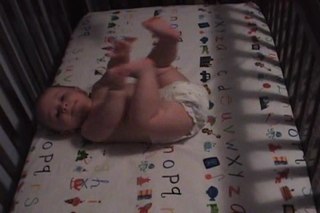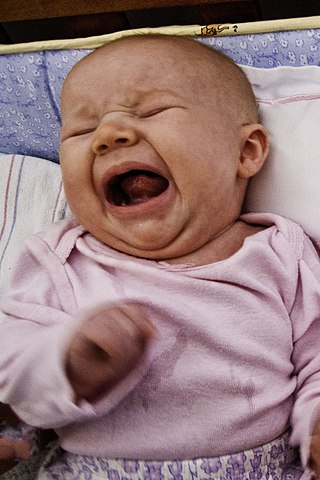Related Research Articles

Developmental psychology is the scientific study of how and why humans grow, change, and adapt across the course of their lives. Originally concerned with infants and children, the field has expanded to include adolescence, adult development, aging, and the entire lifespan. Developmental psychologists aim to explain how thinking, feeling, and behaviors change throughout life. This field examines change across three major dimensions, which are physical development, cognitive development, and social emotional development. Within these three dimensions are a broad range of topics including motor skills, executive functions, moral understanding, language acquisition, social change, personality, emotional development, self-concept, and identity formation.

Babbling is a stage in child development and a state in language acquisition during which an infant appears to be experimenting with uttering articulate sounds, but does not yet produce any recognizable words. Babbling begins shortly after birth and progresses through several stages as the infant's repertoire of sounds expands and vocalizations become more speech-like. Infants typically begin to produce recognizable words when they are around 12 months of age, though babbling may continue for some time afterward.

In philosophy of self, self-awareness is the experience of one's own personality or individuality. It is not to be confused with consciousness in the sense of qualia. While consciousness is being aware of one's body and environment, self-awareness is the recognition of that consciousness. Self-awareness is how an individual experiences and understands their own character, feelings, motives, and desires.

Imitation is a behavior whereby an individual observes and replicates another's behavior. Imitation is also a form of that leads to the "development of traditions, and ultimately our culture. It allows for the transfer of information between individuals and down generations without the need for genetic inheritance." The word imitation can be applied in many contexts, ranging from animal training to politics. The term generally refers to conscious behavior; subconscious imitation is termed mirroring.

Harry Frederick Harlow was an American psychologist best known for his maternal-separation, dependency needs, and social isolation experiments on rhesus monkeys, which manifested the importance of caregiving and companionship to social and cognitive development. He conducted most of his research at the University of Wisconsin–Madison, where humanistic psychologist Abraham Maslow worked with him for a short period of time.
Perceptual control theory (PCT) is a model of behavior based on the properties of negative feedback control loops. A control loop maintains a sensed variable at or near a reference value by means of the effects of its outputs upon that variable, as mediated by physical properties of the environment. In engineering control theory, reference values are set by a user outside the system. An example is a thermostat. In a living organism, reference values for controlled perceptual variables are endogenously maintained. Biological homeostasis and reflexes are simple, low-level examples. The discovery of mathematical principles of control introduced a way to model a negative feedback loop closed through the environment, which spawned perceptual control theory. It differs fundamentally from some models in behavioral and cognitive psychology that model stimuli as causes of behavior. PCT research is published in experimental psychology, neuroscience, ethology, anthropology, linguistics, sociology, robotics, developmental psychology, organizational psychology and management, and a number of other fields. PCT has been applied to design and administration of educational systems, and has led to a psychotherapy called the method of levels.
Rachel Barr is a professor at Georgetown University. She is currently the co-director of graduate studies in the Department of Psychology at Georgetown University. Her research focuses on understanding the learning and memory mechanisms that develop during infancy. Because infants are preverbal, her techniques rely on imitation and learning methods to find out what infants have learned and how well and how long they remember it. Her previous research has focused on how infants pick up information from different media sources, television, siblings, adults, and different contexts. Most recently, Barr's studies focus on factors that might enhance infant learning from television.
Mary Dinsmore Ainsworth was an American-Canadian developmental psychologist known for her work in the development of the attachment theory. She designed the strange situation procedure to observe early emotional attachment between a child and their primary caregiver.
Evolutionary developmental psychology (EDP) is a research paradigm that applies the basic principles of evolution by natural selection, to understand the development of human behavior and cognition. It involves the study of both the genetic and environmental mechanisms that underlie the development of social and cognitive competencies, as well as the epigenetic processes that adapt these competencies to local conditions.

Attachment in children is "a biological instinct in which proximity to an attachment figure is sought when the child senses or perceives threat or discomfort. Attachment behaviour anticipates a response by the attachment figure which will remove threat or discomfort". Attachment also describes the function of availability, which is the degree to which the authoritative figure is responsive to the child's needs and shares communication with them. Childhood attachment can define characteristics that will shape the child's sense of self, their forms of emotion-regulation, and how they carry out relationships with others. Attachment is found in all mammals to some degree, especially primates.

Child development involves the biological, psychological and emotional changes that occur in human beings between birth and the conclusion of adolescence.
Co-regulation is a term used in psychology. It is defined most broadly as a "continuous unfolding of individual action that is susceptible to being continuously modified by the continuously changing actions of the partner". An important aspect of this idea is that co-regulation cannot be reduced down to the behaviors or experiences of the individuals involved in the interaction. The interaction is a result of each participant repeatedly regulating the behavior of the other. It is a continuous and dynamic process, rather than the exchange of discrete information.

Joint attention or shared attention is the shared focus of two individuals on an object. It is achieved when one individual alerts another to an object by means of eye-gazing, pointing or other verbal or non-verbal indications. An individual gazes at another individual, points to an object and then returns their gaze to the individual. Scaife and Bruner were the first researchers to present a cross-sectional description of children's ability to follow eye gaze in 1975. They found that most eight- to ten-month-old children followed a line of regard, and that all 11- to 14-month-old children did so. This early research showed it was possible for an adult to bring certain objects in the environment to an infant's attention using eye gaze.

Laura-Ann Petitto is a cognitive neuroscientist and a developmental cognitive neuroscientist known for her research and scientific discoveries involving the language capacity of chimpanzees, the biological bases of language in humans, especially early language acquisition, early reading, and bilingualism, bilingual reading, and the bilingual brain. Significant scientific discoveries include the existence of linguistic babbling on the hands of deaf babies and the equivalent neural processing of signed and spoken languages in the human brain. She is recognized for her contributions to the creation of the new scientific discipline, called educational neuroscience. Petitto chaired a new undergraduate department at Dartmouth College, called "Educational Neuroscience and Human Development" (2002-2007), and was a Co-Principal Investigator in the National Science Foundation and Dartmouth's Science of Learning Center, called the "Center for Cognitive and Educational Neuroscience" (2004-2007). At Gallaudet University (2011–present), Petitto led a team in the creation of the first PhD in Educational Neuroscience program in the United States. Petitto is the Co-Principal Investigator as well as Science Director of the National Science Foundation and Gallaudet University’s Science of Learning Center, called the "Visual Language and Visual Learning Center (VL2)". Petitto is also founder and Scientific Director of the Brain and Language Laboratory for Neuroimaging (“BL2”) at Gallaudet University.
The strange situation is a procedure devised by Mary Ainsworth in the 1970s to observe attachment in children, that is relationships between a caregiver and child. It applies to children between the age of nine and 30 months. Broadly speaking, the attachment styles were (1) secure and (2) insecure. Later, Mary Main and her husband Erik Hesse introduced the 4th category, disorganized. The procedure played an important role in the development of attachment theory.

Kenneth Kaye was an American psychologist and writer whose research, books, and articles connect the fields of human development, family relationships and conflict resolution.
Mary Main was an American psychologist notable for her work in the field of attachment. A Professor at the University of California Berkeley, Main is particularly known for her introduction of the 'disorganized' infant attachment classification and for development of the Adult Attachment Interview and coding system for assessing states of mind regarding attachment. This work has been described as 'revolutionary' and Main has been described as having 'unprecedented resonance and influence' in the field of psychology.

Maternal sensitivity is a mother's ability to perceive and infer the meaning behind her infant's behavioural signals, and to respond to them promptly and appropriately. Maternal sensitivity affects child development at all stages through life, from infancy, all the way to adulthood. In general, more sensitive mothers have healthier, more socially and cognitively developed children than those who are not as sensitive. Also, maternal sensitivity has been found to affect the person psychologically even as an adult. Adults who experienced high maternal sensitivity during their childhood were found to be more secure than those who experienced less sensitive mothers. Once the adult becomes a parent themselves, their own understanding of maternal sensitivity will affect their own children's development. Some research suggests that adult mothers display more maternal sensitivity than adolescent mothers who may in turn have children with a lower IQ and reading level than children of adult mothers.

Infant crying is the crying of infants as a response to an internal or external stimulus. Infants cry as a form of basic instinctive communication. Essentially, newborns are transitioning from life in the womb to the external environment. Up to 27% of parents describe problems with infant crying in the first four months. Up to 38% identify a problem with their infant crying within the first year. Parents can be concerned about the amount of time that their infant cries, how the infant can be consoled, and disrupted sleeping patterns. Colic is used as a synonym for excessive crying of infants, even though colic may not be the cause of excessive crying.
Malinda Carpenter,Ph.D, FRSE is a professor of developmental psychology at the University of St Andrews, an international researcher specialising in infant and child communications, prosocial behaviour and group reactions, in how people learn to understand others, and building self esteem; her work includes research between ape and human social cognition, and more recently in considering human-robotic communication futures.
References
- ↑ Vanderijt, Hetty; Plooij, Frans X. (2003). The wonder weeks: how to turn your baby's 8 great fussy phases into magical leaps forward. Emmaus, Pa: Rodale. ISBN 978-1-57954-645-8.
- ↑ Van De Rijt, Hetty; Plooij, Frans X. (1992). Oei, ik groei![Ai, I'm growing!] (in Dutch). Ede and Antwerp: Zomer & Keuning Boeken BV.
- 1 2 Verhoeven, Eymeke (2018-03-07). "Je kind loopt nog niet? Maakt niet uit" [Your child isn't walking yet? It doesn't matter]. Nederlands Dagblad (in Dutch). Retrieved 2024-02-25.
- ↑ Kalverboer, L. (1998). "Ontwikkelingssprongen in het duister: Over transities in de ontwikkeling" [Developmental leaps in the dark: On transitions in development]. Neuropraxis. 1. doi:10.1007/BF03070912.
Verloopt het vroegkinderlijke ontwikkelingsproces geleidelijk of sprongsgewijs? Deze vraag houdt onderzoekers bezig sinds het begin van deze eeuw, toen de systematische studie van de ontwikkeling van het kind begon.
[Is the early childhood development process gradual or in leaps? This question has preoccupied researchers since the beginning of this century, when the systematic study of child development began.] - 1 2 3 4 Wapner, Jessica (2020-04-16). "Are Sleep Regressions Real?". The New York Times. ISSN 0362-4331. Archived from the original on 2023-06-05. Retrieved 2023-12-17.
- ↑ Rijt, Hetty van de; Plooij, Frans X.; Plas-Plooij, Xaveira (September 2019). The Wonder Weeks: A Stress-Free Guide to Your Baby's Behavior. New York: W. W. Norton. p. 464. ISBN 978-1-68268-427-6.
- ↑ "The Wonder Weeks App". The Wonder Weeks. Retrieved 2017-08-27.
- ↑ The Wonder Weeks (2019 ed.) p. 23.
- ↑ Ibid. p. 22.
- ↑ Horwich, Robert H. (1974). ""Regressive Periods in Primate Behavioral Development with Reference to Other Mammals"". Primates. 15 (2–3): 141–149. doi:10.1007/BF01742277. S2CID 6922407 . Retrieved 2024-02-26.
- ↑ Hinde, R.A., ed. (1983). Primate Social Relationships: An Integrated Approach. Oxford: Blackwell Scientific.
- ↑ "Before our research, such regression phases had been found by others in 12 other primate species and two lower mammalian species, indicating that this appears to be an old phenomenon, perhaps emerging during the very evolution of life on earth" ("Introduction" (by F.X. Plooij), ibid. p. 15).
- ↑ Rojas-Rocha, Xochitl (2014-08-22). "Gombe chimpanzee calls available after 40-year wait". Science News. No. 22579. American Association for the Advancement of Science. Retrieved 2024-02-25.
- ↑ Plooij, F.X. (1984). Lipsitt, L.P. (ed.). "The Behavioral Development of Free-living Chimpanzee Babies and Infants". Monographs on Infancy. 3. New York: Ablex Publishing: 1–207.
- ↑ van de Rijt-Plooij, H.H.C.; Plooij, F. X. (1987). "Growing independence, conflict and learning in mother-infant relations in free-ranging chimpanzees". Behaviour. 101 (1–3): 1–86. doi:10.1163/156853987X00378.
- ↑ van de Rijt-Plooij, H.H.C.; Plooij, F. X. (1988). "Mother-infant relations, conflict, stress and illness among free-ranging chimpanzees". Developmental Medicine & Child Neurology. 30 (3): 306–15. PMID 3402672.
- ↑ Plooij, F. X.; van de Rijt-Plooij, H.H.C. (1989). "Evolution of human parenting: Canalization, new types of learning, and mother-infant conflict". European Journal of Psychology of Education. 4: 177–192. doi:10.1007/BF03172599.
- ↑ Van De Rijt-Plooij, Hedwig H.C.; Plooij, Frans X. (July 1992). "Infantile regressions: Disorganization and the onset of transition periods". Journal of Reproductive and Infant Psychology. 10 (3): 129–149. doi:10.1080/02646839208403946. ISSN 0264-6838.
- ↑ In the same year the first version of this book for the general public was published in the Dutch language. Van De Rijt, Hetty; Plooij, Frans X. (1992). Oei, ik groei![Ai, I'm growing!] (in Dutch). Ede and Antwerp: Zomer & Keuning Boeken BV.
- ↑ Plooij, F. X.; Rijt-Plooij, H. H. C. van de (1990). "Developmental transitions as successive reorganizations of a control hierarchy". American Behavioral Scientist. 34 (1): 67–80. doi:10.1177/0002764290034001007. S2CID 144183592.
- ↑ Trevarthen, C.; Aitken, K. (2003). "Regulation of Brain Development and Age-Related Changes in Infants' Motives: The Developmental Function of Regressive Periods". In Heimann, Mikael (ed.). Regression periods in human infancy. Mahwah, NJ: Erlbaum. pp. 107–184. ISBN 0-8058-4098-2.
- ↑ Plooij, Frans X.; Rijt-Plooij, Hedwig H.C. van de; Stelt, Jeannette M. van der; Es, Bert van; Helmers, Roelof (2003). "Chapter 6: Illness Peaks During Infancy and Regression Periods". In Heimann, Mikael (ed.). Regression Periods in Human Infancy. Lawrence Erlbaum Associates. pp. 81–96.
- ↑ Plooij, Frans X.; Rijt-Plooij, Hedwig H.C. van de; Helmers, Roelof (2003). "Chapter 7: Multimodal Distribution of SIDS and Regression Periods". In Heimann, Mikael (ed.). Regression Periods in Human Infancy. Lawrence Erlbaum Associates. pp. 97–106.
- ↑ Sadurni, M.; Burriel, M. P.; Plooij, F. X. (2010). "The temporal relation between regression and transition periods in early infancy". The Spanish Journal of Psychology. 13 (1): 112–126.
- ↑ de Weerth, C.; van Geert, P. (1998-03-01). "Emotional instability as an indicator of strictly timed infantile developmental transitions". British Journal of Developmental Psychology. 16 (1): 15–44. doi:10.1111/j.2044-835X.1998.tb00748.x. ISSN 2044-835X.
- 1 2 3 Kok, Annemarie (1997-11-19). "'Oei, ik groei!' leidt tot bittere ruzie van wetenschappers". Trouw. Retrieved 14 June 2015.
- ↑ Woomore, Aslhley; Richer, John (2003). "Chapter 3: Detecting Infant Regression Periods: Weak Signals in a Noisy Environment". In Heimann, Mikael (ed.). Regression periods in human infancy. Mahwah, NJ: Erlbaum. pp. 23–40. ISBN 0-8058-4098-2.
- ↑ Plooij, F. X.; van de Rijt-Plooij, H.H.C. (2003). "Chapter 5: The Effects of Sources of "Noise" on Direct Observation Measures of Regression Periods: Case Studies of Four Infants' Adaptations to Parental Conditions". In Heimann, Mikael (ed.). Regression periods in human infancy. Mahwah, NJ: Erlbaum. pp. 57–80. ISBN 0-8058-4098-2.
- ↑ Ibid.
- ↑ "'Oei, ik groei!' leidt tot bittere ruzie van wetenschappers". Trouw (in Dutch). Archived from the original on 2017-08-27. Retrieved 2017-08-27.
zeer onfatsoenlijk
- ↑ Dirks, Bart (January 13, 1997). "Hoogleraar woedend over weerlegging theorie". Algemeen Dagblad (AD). Retrieved 14 June 2015.
- ↑ Dirks, Bart (1998-01-14). "Positie Plooij onhoudbaar na openlijke kritiek op oud-promovenda; Auteur 'Oei, ik groei' ontslagen als hoogleraar". Volkskrant. Retrieved 14 June 2015.